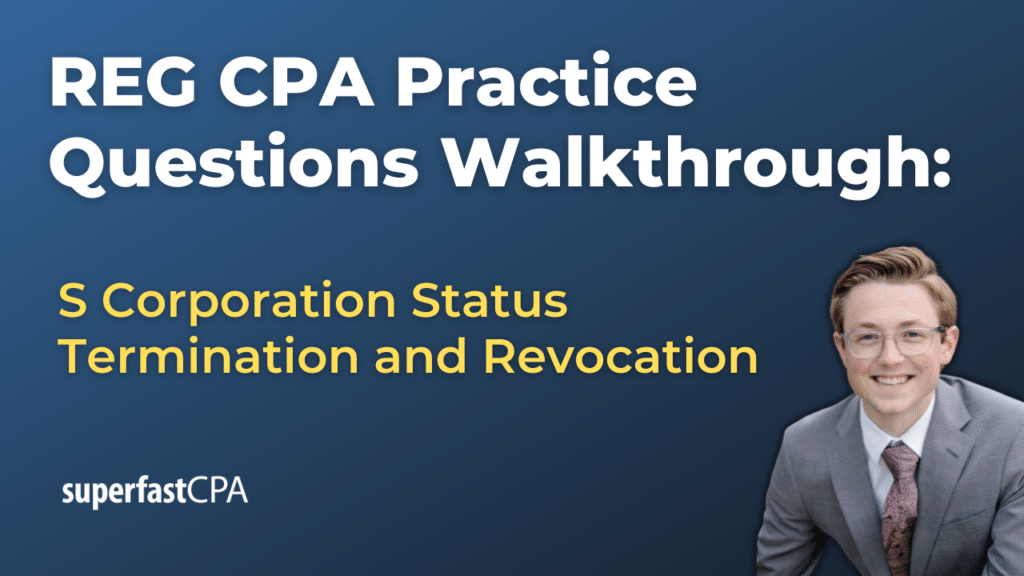In this video, we walk through 5 REG practice questions teaching the rules around S Corporation status termination and revocation. These questions are from REG content area 5 on the AICPA CPA exam blueprints: Federal Taxation of Entities.
The best way to use this video is to pause each time we get to a new question in the video, and then make your own attempt at the question before watching us go through it.
Also be sure to watch one of our free webinars on the 6 “key ingredients” to an extremely effective & efficient CPA study process here…
Learning About S Corporation Status Termination and Revocation
S Corporation Election Requirements:
An S corporation election allows a corporation to pass corporate income, losses, deductions, and credits to shareholders for federal tax purposes. To become an S corporation, the following requirements must be met:
- Domestic Corporation: The corporation must be a domestic entity.
- Eligible Shareholders: Shareholders can include individuals, certain trusts, and estates, but not partnerships, corporations, or non-resident aliens.
- Number of Shareholders: There must be 100 shareholders or fewer.
- One Class of Stock: The corporation can only have one class of stock, though differences in voting rights are permitted.
- Timely Election: The election is made with Form 2553 and must be filed no more than two months and 15 days after the beginning of the tax year the election is to take effect.
- Consent: All current shareholders must consent to the election.
Causes for Termination of S Corporation Status:
S corporation status can be terminated if any of the following occur:
- Ineligible Shareholder: If the corporation issues stock to an ineligible shareholder, such as a partnership or non-resident alien.
- Excessive Number of Shareholders: If the number of shareholders exceeds 100.
- Multiple Classes of Stock: If the corporation issues more than one class of stock.
- Failure to Meet IRS Requirements: Noncompliance with any IRS regulations pertinent to S corporations.
Riverbend Books, a small bookstore, elected S corporation status in Year 1 with its single owner, Sarah, as the sole shareholder. In Year 4, to raise capital for expansion, Sarah sold shares to a local business, Townsend LLC, which is treated as a partnership for tax purposes. Unaware that partnerships are ineligible shareholders for S corporations, Sarah continued to operate Riverbend Books as an S corporation.
Upon review, the IRS determined that Riverbend Books had an ineligible shareholder, Townsend LLC, since an LLC treated as a partnership cannot hold shares in an S corporation. This breach of the eligibility requirements led to the automatic termination of Riverbend Books S corporation status as of the date the shares were sold to the LLC. Consequently, the company was treated as a C corporation for tax purposes from that point forward, subjecting it to corporate tax rates and eliminating the pass-through taxation benefit.
Rules for Voluntary Revocation of S Corporation Status:
A corporation may voluntarily revoke its S corporation status by:
- Shareholder Approval: Having a revocation statement consented to by shareholders holding more than 50% of the shares (including nonvoting shares).
- Effective Date: The revocation can specify an effective date or be effective immediately upon filing.
- Filing Requirement: The revocation must be filed with the IRS.
Special Rule for Former C Corporations:
For an S corporation that was previously a C corporation, there’s an additional risk of termination:
- Passive Income Limitation: If the S corporation has accumulated earnings and profits from its C corporation years, and it has gross receipts of more than 25% from passive income (interest, dividends, rents, etc.) for three consecutive years, the S corporation status will be terminated beginning with the fourth tax year.
In summary, while an S corporation can offer significant tax benefits, it must strictly adhere to the IRS’s eligibility criteria. The corporation and its shareholders must be vigilant in maintaining compliance, especially when the corporation transitions from C to S status, as the rules around passive income become important to avoid involuntary termination.













